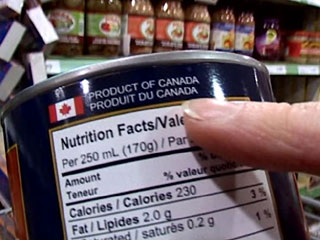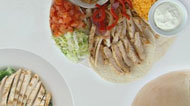Product of Canada, eh?
October 24, 2007The Show
It says "Product of Canada" on the package, but the food is really from China. Or New Zealand. Or...
Eating local is hot this year. Restaurant menus across the country boast of fresh local meat and produce. Bestselling books encourage us to take up the "100-Mile Diet."
Almost everywhere, there's a growing sense that it would be smart to reduce our consumption of food that's traveled halfway around the world.
Partly this is about flavour, and the idea that less travel means fresher food that tastes better. Partly it's about safety: being sure that food from where we live is subject to Canadian standards and inspections. Partly it's about supporting farmers who live nearby. Partly it's about using less fuel for the sake of the planet. So there are plenty of reasons to look for the "Product of Canada" label in the grocery store.
But here's the thing. "Product of Canada" doesn't actually mean the food is from around here. All it means, legally speaking, is that at least 51% percent of its production costs were spent in Canada. As Wendy Mesley's report reveals, sometimes "Product of Canada" has been to three continents before it lands here.
Also: Ever heard of "butteroil-sugar blend"?
October 24, 2007
139 Comments | E-mail | Share on Facebook | Save on del.icio.us | Post to Digg
How to really eat local
Normally in this space you would see the words "read the label." In this case, you have to really read the label. Watch for any of the following words and phrases:
- modified milk ingredients
- skim milk powder
- milk protein concentrates
- milk protein isolates
- casein
- caseinates
- whey protein concentrates
Finally, here are a few quick tips.
If it claims to be ice cream but doesn't contain any cream, it may not be from not from around here. Authentically Canadian cheese will always contain milk.
Look for authentic local garlic at specialty shops or in farmers' markets. You won't find it in supermarkets.
The more processed a food is, the more obscure its origins become, because of the 51% rule. If you buy fresh vegetables and meats instead of TV dinners you'll have an easier time figuring out where it all came from.
Ask. Many packaged foods have toll-free numbers for customer enquiries. If you don't get a satisfactory answer, let the people on the phone know that the issue is important to you, and that you're prepared to switch brands over it.
October 24, 2007
26 Comments | E-mail | Share on Facebook | Save on del.icio.us | Post to Digg
Some more detail about fish inspection
Many of you have posted comments asking questions about specific fish processors. Here's a little more detail.
There are between 20 and 30 companies on the enhanced importers list in Canada, including High Liner. These companies do their own inspections and are audited by the CFIA. Under the Quality Management Program for Importers (QMPI), importers must inspect the products they import following procedures and standards that are at least equivalent to the ones used by the CFIA. This means that these importers have to follow, as a minimum, the inspection frequencies set by the CFIA, such as 100% hold and test for products on the Import Alert List and for products targeted by special surveillance programs (e.g. aquaculture finfish from China and Vietnam).
Thanks for your comments, and thanks for watching!
--Bret
October 24, 2007
5 Comments | E-mail | Share on Facebook | Save on del.icio.us | Post to Digg
Ice Cream & Cheese
Under current law, only a limited amount of fluid milk and cream can be imported tariff-free into Canada. "Modified milk ingredients" are a different story. That name can mean just about any product that was initally part of milk, especially including the following:
- skim milk powder
- milk protein concentrates
- milk protein isolates
- casein
- caseinates
- whey protein concentrates
It's possible to make products such as cheese and ice cream using only modified milk ingredients and no fluid milk or cream at all.
Here are some quick cheese facts:
- The substitution of milk protein concentrate for milk is most common in lower quality, less expensive products such as generic cheddar and mozzarella
- Essentially all the milk protein concentrate used in Canada is imported. New Zealand is the major source; it also comes from Europe and U.S.
- Because of price controls on Canadian dairy products, imported milk protein concentrate costs much less than than comparable Canadian product does.
- There is currently no way for consumers to know how much fluid (and therefore Canadian) milk is in Canadian cheese
Now on to some quick ice cream facts.
- Many of the ice creams for sale in Canada only list "modified milk ingredients" on their labels, and no milk or cream at all.
- Only 12 of the country's 50 dairies actually use 100 per cent Canadian cream in their ice cream.
- The others, including such big players as Good Humor-Breyers, Chapmans and Nestlé, use cream in only some of their products as the source of fat.
- Others use only cheaper imported butteroil-sugar blend (modified milk ingredients mixed with sugar) or a blend of domestic and imported butteroil.
What is butteroil-sugar blend? It was invented to get around tariffs on imported milk ingredients. Because it is 51 percent sugar, it is legally classified as a confectionery product, not a dairy one. There is no limit to the amount of butteroil-sugar blend that can be imported into Canada.
After it was classified this way, manufacturers jumped on it: The volume of butteroil-sugar blend imports increased 488% in just over 18 months between 1995 and 1997.
October 24, 2007
17 Comments | E-mail | Share on Facebook | Save on del.icio.us | Post to Digg
Garlic
Prepared garlic (that's the peeled, ready-to-use stuff in jars) almost always says "Product of Canada" on the label. It's mostly grown in China. Here's a quick timeline:
- 1997 - The Canadian International Trade Tribunal finds Chinese garlic is being illegally dumped here. China is selling garlic to Canada for $0.58/kg, compared with the normal price of $1.91/kg. The CITT introduces a tariff on Chinese garlic that will be in effect from July to December - the Canadian garlic growing season. At this time 68 percent of Canada’s fresh garlic imports come from China.
- 2000 - Garlic growers ask for a review of the time period after China starts importing almost all of its garlic during the January-to-June window to avoid the tariff. Despite the July-to-December tariff, China exports more garlic to Canada this year than it ever has before.
- 2000 - The tariff is expanded to the whole year and to garlic from Vietnam.
- 2002 - The tariff is renewed for another 5 years. Chinese imports suddenly drop, from $2 million the year before to $200,000 in 2002. At the same time, imports of garlic from the Philippines suddenly jump, from $2 million to $6 million. The Garlic Growers of Ontario believe China is illegally exporting through the Philippines to avoid the tariff.
- 2007 - The Canadian tariff expires again, this time without much of a fight. Most Canadian growers are out of business or have turned to other crops. Today, Canadian-grown garlic is mostly found at farmers' markets and in specialty shops.
October 24, 2007
3 Comments | E-mail | Share on Facebook | Save on del.icio.us | Post to Digg
Fish
In Canada, imported fish are subject to the labeling requirements of the Fish Inspection Regulations maintained by the Canadian Food Inspection Agency. Country of origin must be declared on all imported fish product, but only on the container in which it is imported, not necessarily on the retail package. Fish that undergoes transformation (e.g. canning, smoking, salting) in Canada in a federally registered establishment can be labeled "Product of Canada."
Here are some highlights from the fish inspection regulations:
- "No person shall package any fish or mark or label any container of fish in a manner that is false, misleading or deceptive."
- "No person shall import into Canada or attempt to import into Canada any fish unless ... each container has a label on which the name of the country of origin is clearly identified."
The "country of origin" mark is based on the last substantial transformation the product has undergone.
What is "Substantial Transformation"? Any major processing step that changes the original nature of the fish or fish product such that the original product loses its identity and becomes a new product having a new name, character, and use. For example, cod fillets transformed to cod in batter or fresh salmon processed into canned salmon.
So, if a raw salmon were imported from the U.S. and canned in a federally registered facility in Canada, the canned salmon would be "Product of Canada." This regulation is based on the the idea that regardless of a country of origin, the raw fish intended for further processing in Canada must meet Canadian safety and quality standards.
Imported fish that has been only re-packaged or de-boned in Canada cannot be labeled "Product of Canada" because those processes are not considered substantial transformations.
The fish program does not apply the 51 percent rule that applies to such packaged goods as cheese and ready-to-use garlic.
Here are some quick facts about fish and seafood inspection in this country:
- Regular shipments are tested at a rate of 5 percent. The idea that if fish are farmed together in the same water and given the same feed, a small sample will likely reflect any contamination across the entire batch.
- When the CFIA encounters a company or product it hasn't seen before, the entire shipment is held and tested. If it's clean it goes on the "good" list (with 5-percent sampling). If not, it goes on the "bad" list, and all shipments after that are held and tested until four shipments in a row meet Canadian requirements. Then it's over to the "good" list (with 5-percent sampling).
The current 100-percent hold-and-test list includes:
- Farmed finfish from China (hold and test for Malachite Green and Leucomalachite Green)
- Farmed fish from Vietnam (hold and test for Chloramphenicol, Nitrofurans, Malachite Green and Leucomalachite Green) (without certificate; with a certificate the test frequency goes down to 5 percent)
- Farmed eels and eel products from Taiwan (hold and test for Malachite Green and Leucomalachite Green)
- Farmed shrimp from China (hold and test for Nitrofurans)
- The U.S. Food and Drug Administration has a 100 percent hold-and-test on farmed fish from China, and its tests check for gentian violet. (The Canadian agency does not currently perform this test)
October 24, 2007
24 Comments | E-mail | Share on Facebook | Save on del.icio.us | Post to Digg
Product of Canada Credits
"Product of Canada, eh?"
Producer
Jennifer Fowler
Associate Producers
Jennifer Leask
Pamela Smyth
Research
Robert Ballantyne
Editor
Don Chung
Camera
Neith Macdonald
Ed Middleton
Mark Bochsler
Sound
Karndeep Jassal
Dave Fox
Wayne Parsons
Music Consultant
Patrick Russell
October 24, 2007
0 Comments | E-mail | Share on Facebook | Save on del.icio.us | Post to Digg












